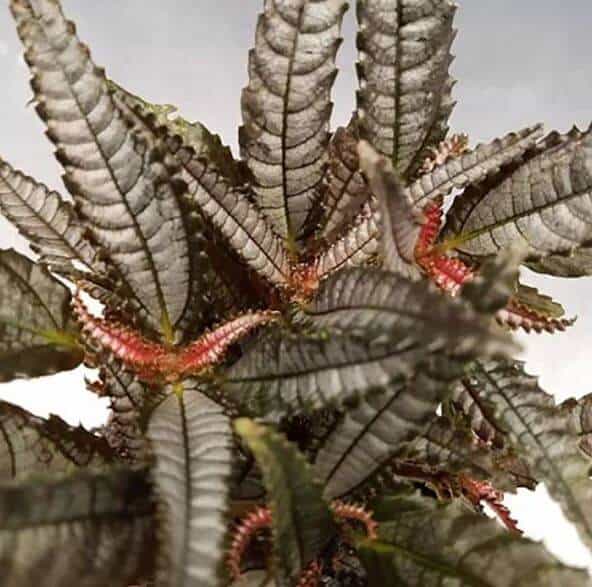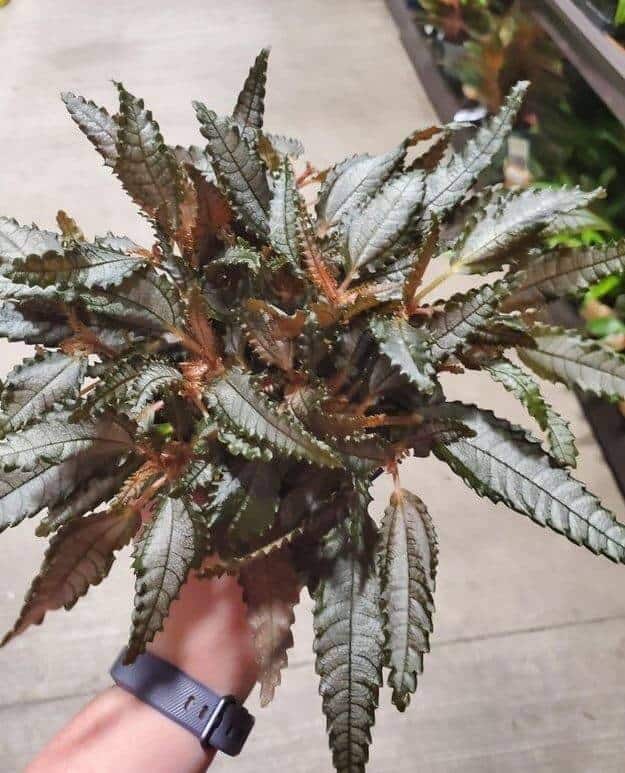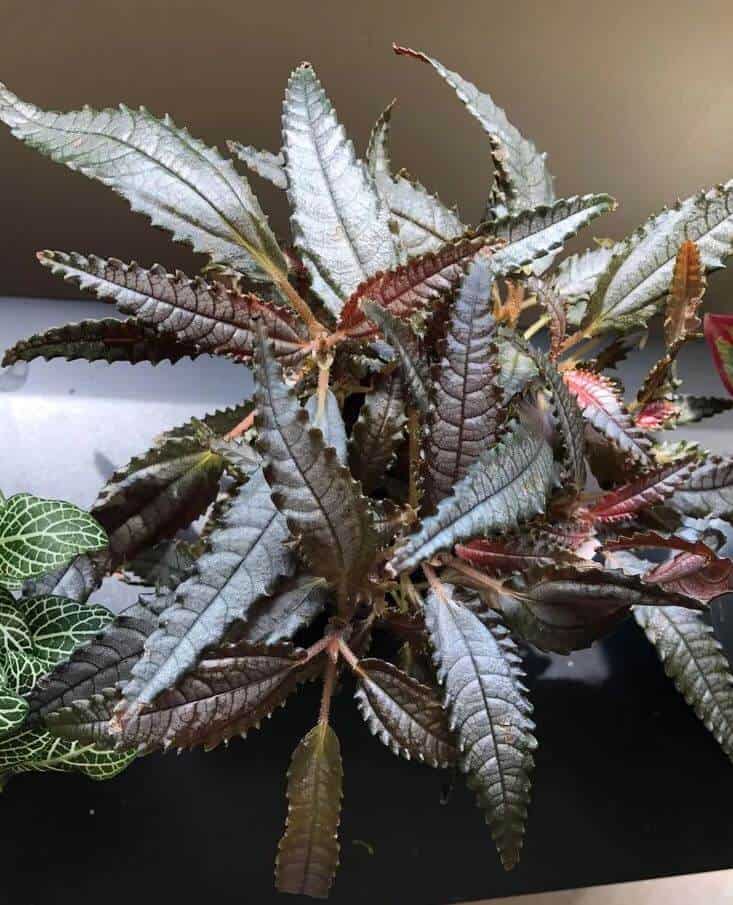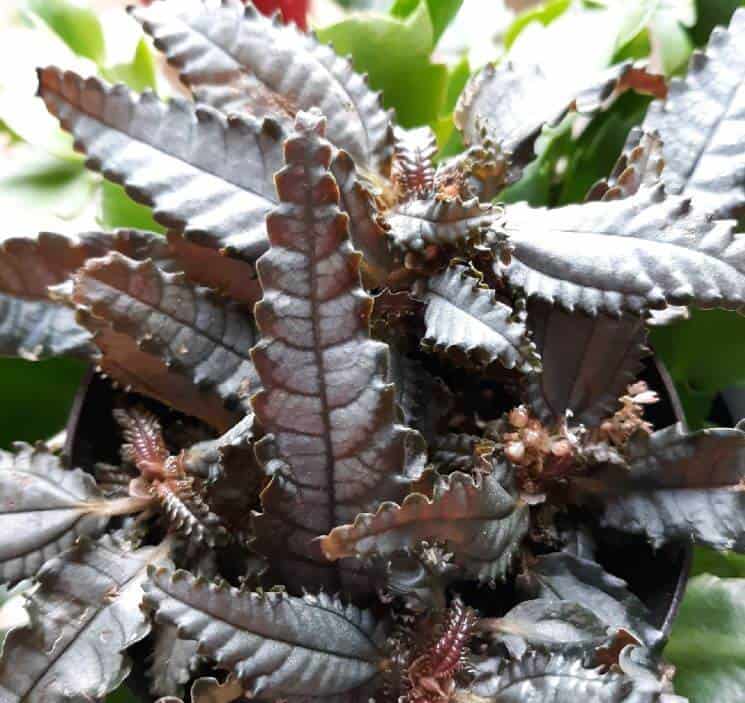Last Updated on January 5, 2023 by a Friendly Gardener
With an intriguing name, the exotic Dark Mystery houseplant is a mysterious Pilea plant indeed with characteristic foliage that is said to resemble lizard tails. If you are looking for a centerpiece plant for an indoor garden, this striking Pilea may fit the bill.
Foliage is a deep green that is tinged with chocolate brown shadowing, and silver streaking that contrasts these deeper hues. The springtime will bring tiny clusters of pink blossoms. New foliage will appear in a shade of rose before darkening with maturity.
This is a smallish plant that has a low growing habit. It can reach 10 inches in height and width. A sun-loving plant, it will grow in the direction of light, so rotation is a must, so your plant grows evenly on all sides.
Botanically known as the Pilea involucrata, this perennial is native to Ecuador and belongs to the Urticaceae family. The Pilea Dark Mystery is perfect near a window providing bright indirect light or as a delightful member of a terrarium.
Dark Mystery Plant Care

An easy-to-care-for houseplant, with the right environmental conditions it will be a stunning addition to your home garden. For those that wish to cultivate these plants outdoors, they can be cultivated in USDA hardiness zones 10 to 11.
Soil

A good quality all-purpose potting soil is a good basis for your growing medium. Add in coco coir or compost as this plant loves a fertile soil bed. As the pilea loves moist soil in tropical and subtropical areas, you can add approximately 2 inches of mulch to the bottom of your pot to aid with water retention. Add in a fistful of perlite or similar to guarantee adequate drainage. Soil pH should measure between 6 and 7.5 as the Dark Mystery plant likes soil that is neutral to slightly acidic.
Light
This is a tropical plant that like a daily dose of sunlight for 6 to 8 hours. It should not be exposed to direct sunlight as this will scorch the lovely foliage. It should be located within 3 feet of a window for your plant to thrive. Windows facing south are ideal. If your plant does not receive sufficient light, leaves will drop. Because this plant will grow toward its light source, rotate it every few days to stimulate even growth all around. Low light conditions are not appropriate for the cultivation of this plant.
Water
The Dark Mystery houseplant likes generous watering. The soil bed should never be allowed to completely dry out. When the top inch feels dry, water. If you under water, the plant’s foliage will begin to droop. You’ll probably be giving your plant approximately a cup of water every week to 10 days as it requires quite a bit of water. You may need to increase this if you have placed your plant in a larger pot. Perlite or coarse sand added to the soil mix will ensure good drainage.
Humidity

The Dark Mystery likes average to slightly humid indoor conditions. Home or office humidity measuring from 40% to 60% is best accompanied by a regular watering schedule. Pebble trays or space humidifiers can help if your home’s air tends to be dry, and you can mist occasionally as well.
Temperature
Indoor home temperatures should measure between 60° and 85°F in the daytime and between 50° and 65° F at night. This is not a plant for colder temperatures and should be kept away from air conditioning vents.
Feeding
If you amend your potting soil with compost, this should provide sufficient nutrients for this Pilea. For an added boost, fertilize your plant once in the spring and again in the summer with a liquid fertilizer formulated for houseplants. Dilute it to half-strength before applying.
Pruning
The Dark Mystery Pilea can appear leggy or scraggly with age, so for a tidier, compact plant, prune away the new growth tips. Trim away lower foliage if they begin to droop and remove damaged or dying leaves. It does not require heavy pruning, just tidying up.
Potting and Repotting

This is a plant that does well when started in a smaller pot, as it likes to be a bit rootbound. Repot your Dark Mystery Pilea when it doubles in size moving it to a larger container. The Dark Mystery’s growth rate is relatively rapid, so plan on repotting annually.
Dark Mystery Plant Propagation

To propagate your plant, use stem cuttings in the springtime.
- Cut a stem section approximately 6 to 8 inches in length with a sterilized sharp garden knife or shears.
- Cuttings should have a few leaves still attached but remove all the leaves from the bottom half of the stem cutting.
- Place your cuttings in a jar of water and position them in a warm location with indirect light.
- Change the water weekly.
- Roots should grow in about a month.
- Plant your cuttings with the new roots in individual pots with fertile potting soil. You may want to stake stems for added support. Place the pots in an environment with at least 65°F room temperature and indirect bright or filtered light.
Dark Mystery Plant Problems
While pretty pest-resistant, the Dark Mystery plant can be attractive to mealybugs and spider mites. You can combat these pests by treating your plant with insecticidal soap or with organic Neem oil.
The Dark Mystery is susceptible to botrytis which generally attacks in the cooler seasons when there is less light. Remove any infected parts and then sterilize your shears to prevent the spread to other plants. Burn infected plant parts as well.
Leaf drop is generally caused by inadequate sunlight. This plant needs a minimum of 6 hours daily of bright light.
Brown spots on leaves indicate too much sun and scorching. Change your plant’s location.
If your plant becomes leggy, it is not receiving adequate light. You can confirm this if the leaves turn darker green as well. Change your plant’s spot.
Dark Mystery Houseplant Toxicity
There are no reports of the Dark Mystery Pilea being toxic, so pets and small children will be safe with this plant in the home.


